Top brand-builders and marketers must be aware of the various tools at their disposal.
Yet, it’s easy to get lost in all the terminology and marketing-based jargon.
That’s why we put together this guide to one of the key tools all brand builders should be aware of: your branding deck.
If you intend to communicate a clear message from a defined position in a distinct and consistent way (which you certainly do), then you need a tool to help you do that.
A branding deck is a brand-building tool that provides leadership teams with the guidance they need to communicate their brand consistently.
Yet, you can use a brand deck for various purposes to help communicate the critical aspects of your brand to different stakeholders.
Let’s get into the nuts and bolts of how you can create a powerful brand deck for your brand.
Let’s start with a more precise definition.
What Is A Branding Deck?

A branding deck is a visual presentation showcasing a company's brand identity, values, mission, and overall brand strategy that the brand’s leadership team and personnel use to communicate the brand.It serves as a comprehensive guide to the company's branding, design elements, positioning strategy and communication framework, which guides the development of all marketing materials, ensuring a consistent brand image and message across all
PRO Brand Strategy BluePrint
Build Brands Like A Pro Brand Strategist

Brand Deck vs Pitch Deck vs Branding Kit vs Brand Style Guide

While these terms may seem interchangeable at first glance, they each serve a distinct purpose.
So, let’s declutter these decks and tools.
Brand Deck

A brand deck is a visual presentation that documents the key aspects of a company's brand, from strategy to identity, including values, mission, positioning, personality, communication and visual identity.
It serves as a foundation for all marketing efforts and helps ensure brand consistency across different channels.
Some of the key elements of a branding deck include brand purpose, values and mission, positioning, personality, verbal identity and visual identity.
We’ll get into the weeds of these shortly.
Pitch Deck

A pitch deck is a presentation you design specifically to pitch a startup or business idea.
The audience is potential investors, partners, or customers.
The primary goal of your pitch deck is to showcase the business concept while demonstrating the market opportunity and highlighting your company's growth potential.
You’ll want to include:
A problem and solution setup: Clearly define the problem the business aims to solve and present the product or service as the solution ( a fundamental part of any marketing strategy!)
The market gap: Demonstrate the size of the target market and the growth potential. This whets the appetite of potential investors who can spot an opportunity.
Your business model: Walk the audience through how you aim to generate revenue. Explicitly detail the path to profitability.
Any traction: If you already have existing customers or partners and you’re generating buzz, share this positivity! Showcasing the milestones you’ve already achieved can act as proof of your potential.
Evidenced financial projections: Reasonably estimating future revenue, expenses, and profits will support the business's growth potential. The people considering investing want to see those enticing graphs that showcase the brand's earning potential.
Branding Kit

A branding kit, or brand identity kit, is the collection of digital and print assets that represent a company's visual identity and messaging.
Ultimately, these are your brand’s visual assets.
You’ll use your branding kit whenever you create brand collateral for your brand to create recognizable brand experiences through every touchpoint.
Your branding kit includes all the design elements, templates, and guidelines you need for brand consistency across various marketing materials.
In it, you’ll have:
Logo files: Different variations and formats of the brand's logo design to use in various situations.
Color palette: The specific colors and color codes that make up your brand's visual identity.
Typography: Your chosen typeface, fonts, font sizes, and font styles for the brand's written content and across all collateral.
Design elements: Various icons, patterns, illustrations, or other visual elements and brand elements you can use in marketing materials.
Templates: Pre-designed templates for presentations, social media posts, business cards, and other marketing collateral.
Brand Style Guide / Brand Guidelines
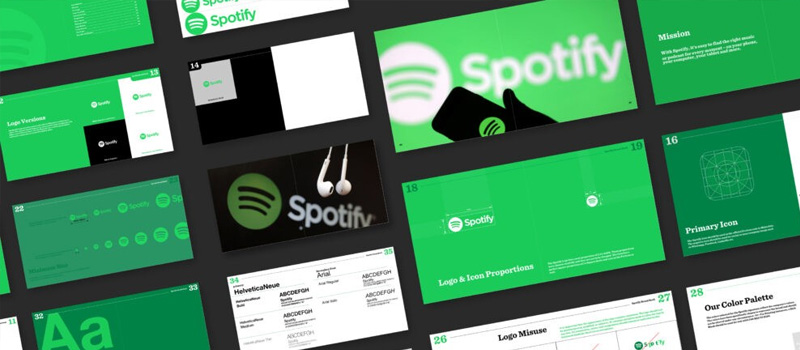
A brand style guide, is a comprehensive document that outlines the rules and best practices for using a company's branding assets and brand design.
The more detailed version, the brand guidelines, is a document outlining the rules of the entire brand, from strategy to visual.
Ultimately, a branding deck and brand guidelines contain the same information designed to guide the communication of the overall brand.
This branding blueprint helps ensure brand consistency by providing clear instructions on how to apply the brand's visual identity, tone of voice, and messaging across different channels.
Say somebody needs to write a blog to sit on the website, design the latest product packaging, craft a social media ad, or design a new physical store.
They’ll need to refer to the brand guidelines to ensure they complete their tasks in a way that preserves the consistency of the brand experience.
Some key parts of your brand guidelines include logo usage, color palette, typography, imagery use, and tone of voice guidelines.
Explore Brand Strategy
Programs & Tools
Why Is A Branding Deck important?

A branding deck plays a crucial role in establishing a company's identity and maintaining brand consistency.
For you as a brand strategist, it should be fairly clear by now that a branding deck is an extremely important tool in your arsenal.
Let’s explore the benefits of a thorough branding deck in more detail.
It helps communicate the brand's story, values, and mission to stakeholders, employees, and customers.
It ensures that all marketing materials, web design, and social media content are on-brand and aligned with the company's overall strategy.
It provides a clear and cohesive direction for graphic design and marketing teams to follow.
A neat brand presentation deck that cohesively lays all this out for you is a must-have resource to refer back to and share with others.
The Elements of a Branding Deck
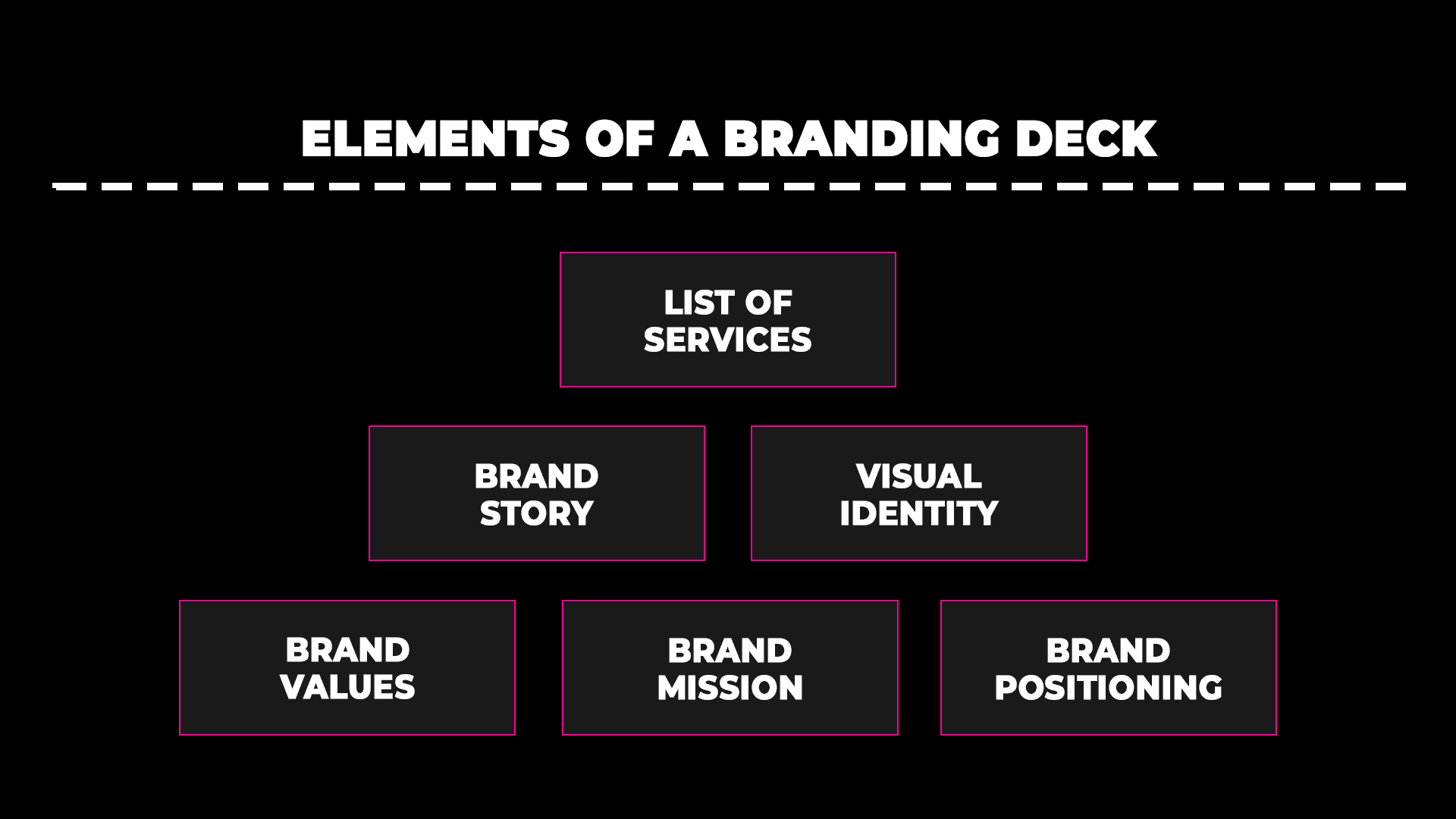
Okay, let’s explore some of the specific building blocks and the nitty-gritty of what really goes into your branding deck.
These are the fundamentals of your broader brand strategy anyway.
It’s all about communicating these effectively to direct the thread of your branding deck.
Brand Values
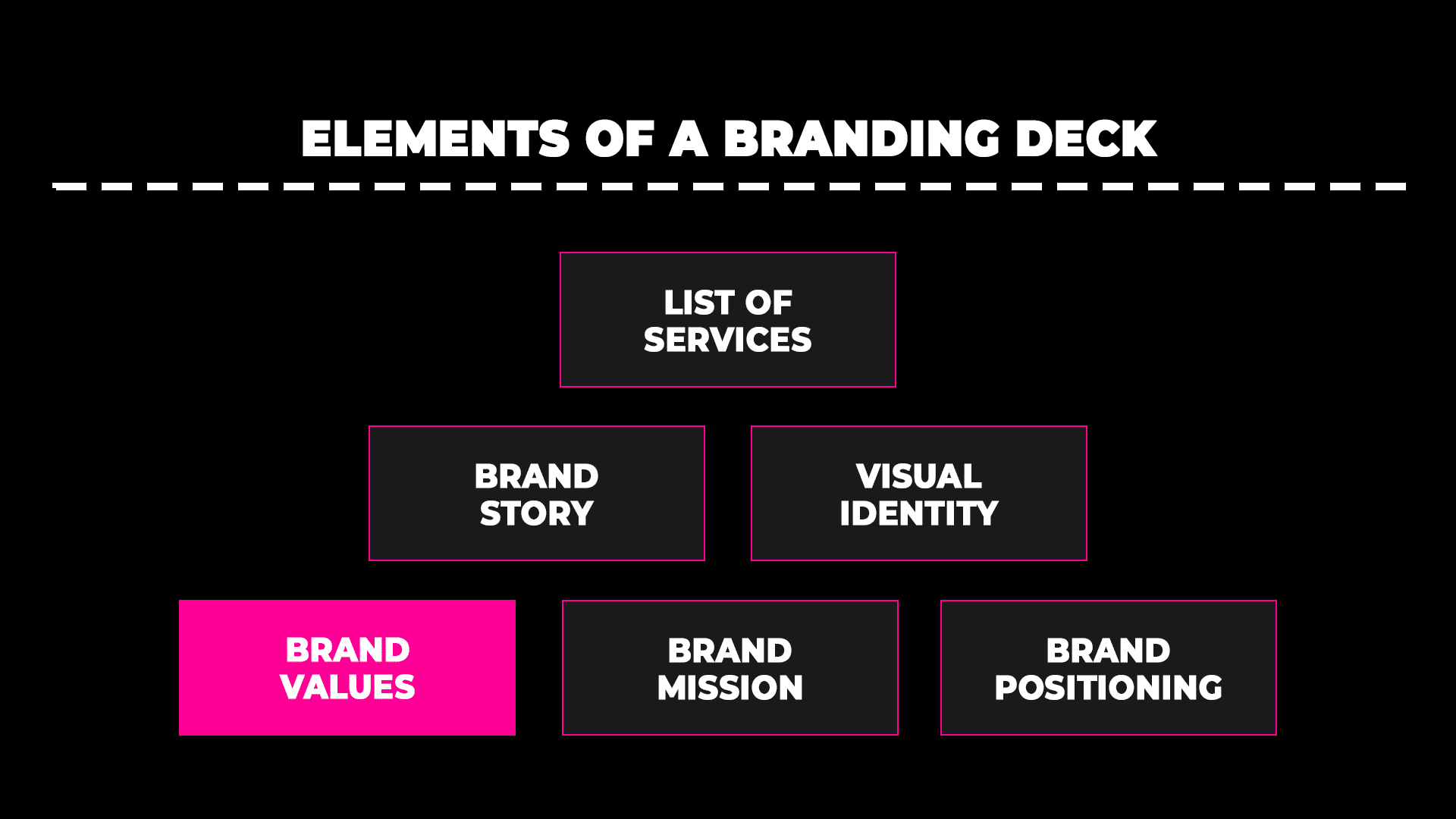
Clearly define the guiding principles that shape your company's decisions and actions.
Align these values with your target audience's priorities and concerns, and make sure they're integrated into your company culture.
Brand Mission

Develop a concise and memorable statement outlining your company's overarching purpose and intended impact.
A great brand mission should serve as an inspiring call-to-action for your team and a commitment to your customers.
Brand Positioning
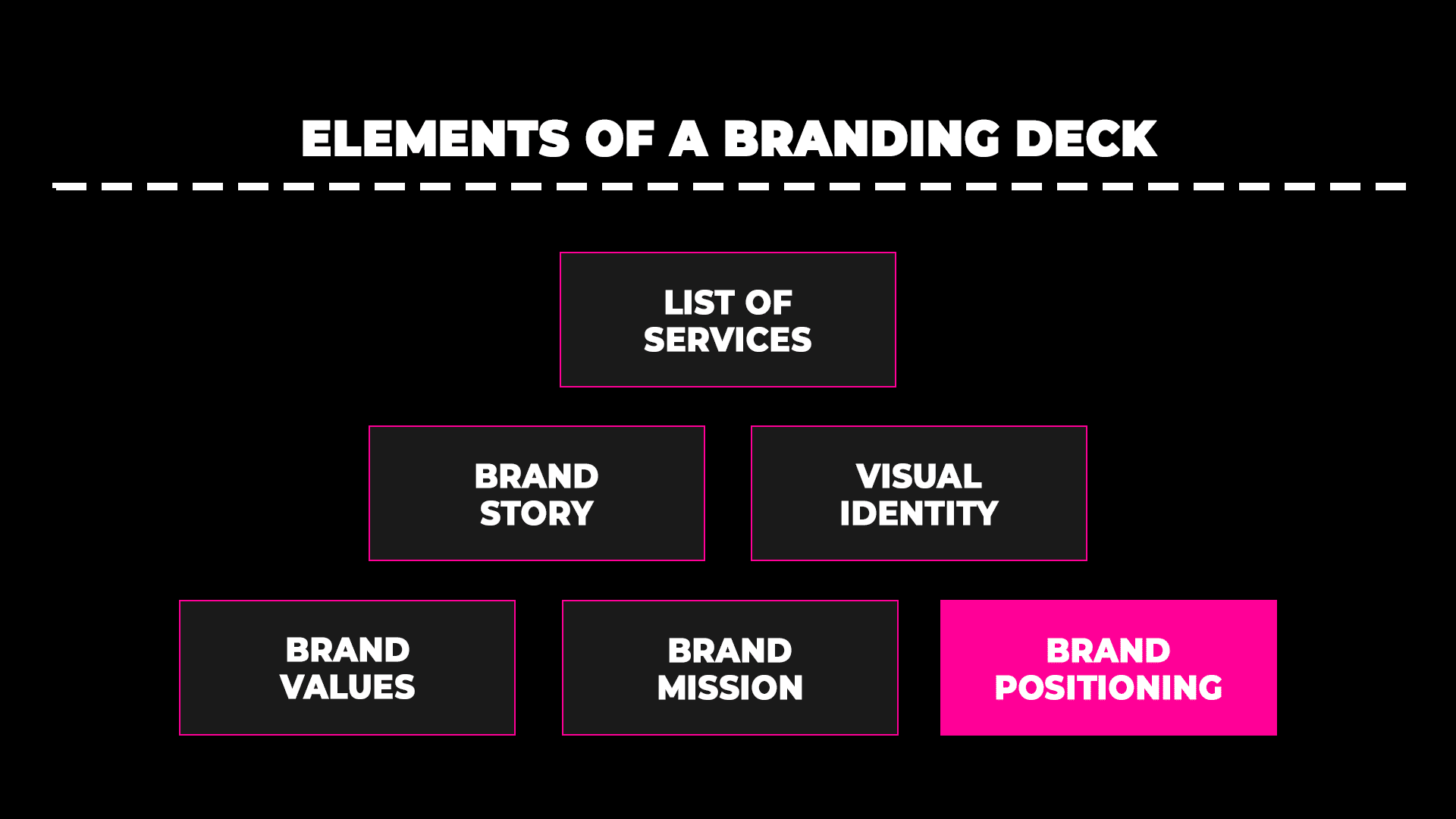
Determine your brand's unique place in the market by identifying your target audience, analyzing your competition, and defining your unique selling proposition (USP).
Effective brand positioning highlights the distinct value your company offers and sets it apart from competitors to establish your brand's unique space in the market.
Brand Story
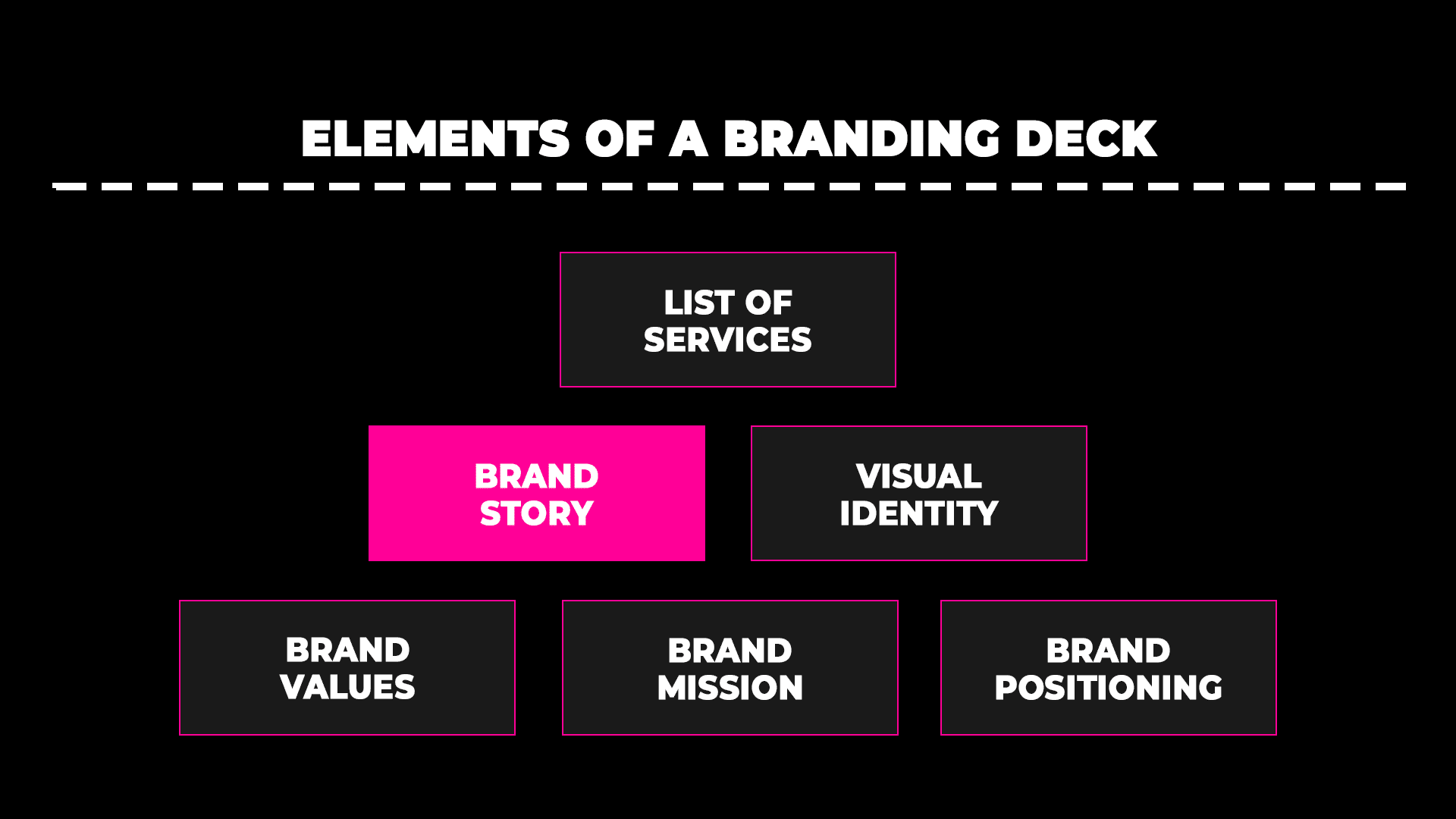
Craft a compelling narrative that captures your company's origin, purpose, and vision.
Your brand story should be engaging, relatable, and evoke an emotional connection with your target audience.
A strong brand story will guide your branding strategy and set the tone for all your marketing efforts.
Focus on sharing your company's history, describing challenges and triumphs, and outlining your vision for the future to create a lasting impact.
Visual Identity

The visual identity of the brand defines the look and feel of the brand and the visual elements and assets used to achieve it.
The visual identity aspect of the brand deck is quite simply, the decks version of the brand style guide, outlining how the visual elements should be used across different environments and channels (and how they shouldn’t).
Product Line or List of Services
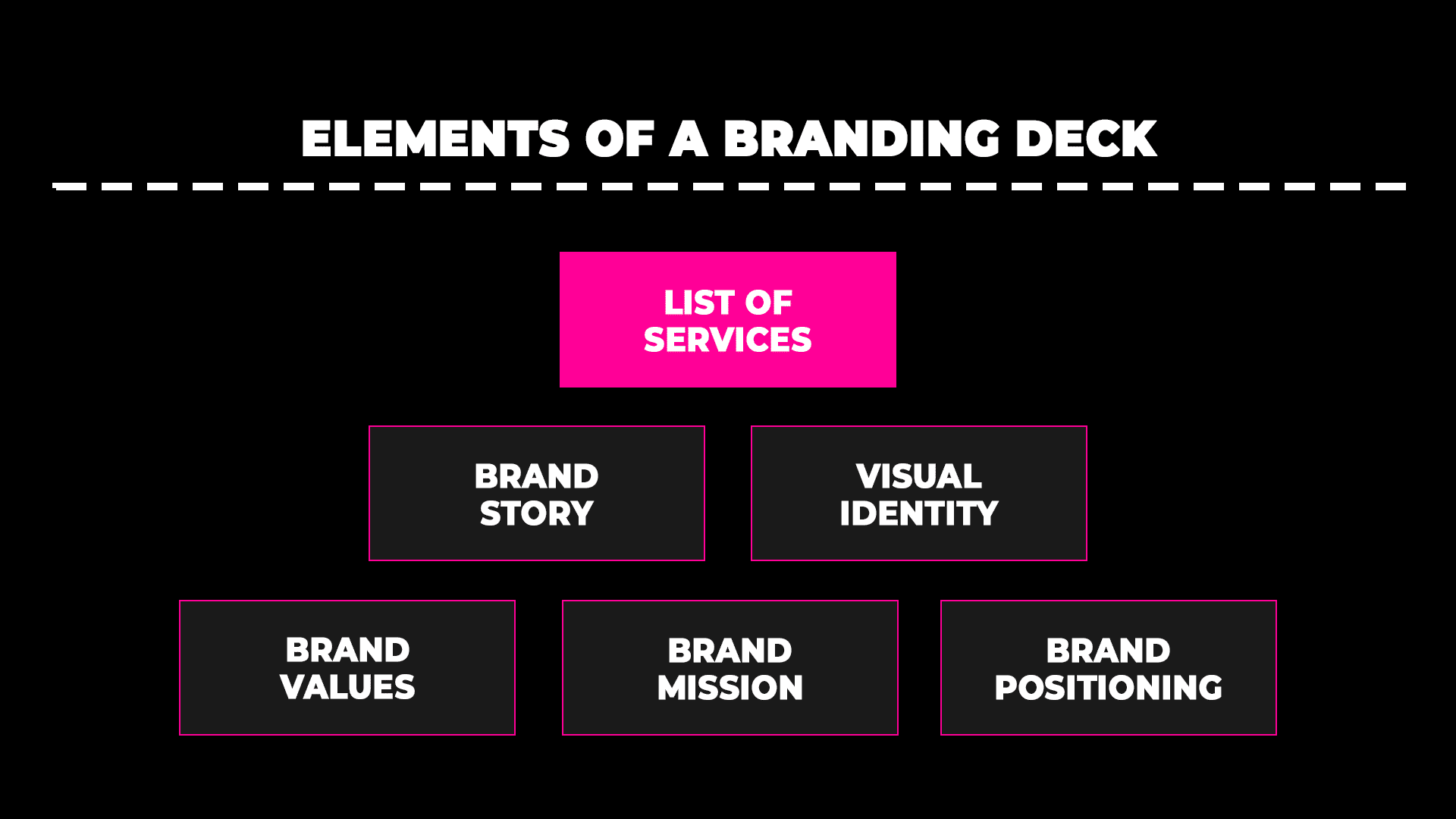
You should include a comprehensive overview of your products or services in your branding deck and any specified communication related to them.
This helps your audience quickly understand the range of offerings your company provides.
To effectively showcase your products or services, make sure you:
Organize your offerings into easy-to-grasp categories
Highlight key features and benefits of each product/service
Use engaging visuals
Branding Deck Presentation Tutorial

Now that we’ve explored the various elements, let’s work out how you fuse it all together into a winning branding deck.
You’ll need to consider your foundational strategy, craft the deck with care to make it accessible for viewers, and then understand that your deck is an ever-evolving project as your brand changes over time.
#1. Define Your Brand Strategy

Start from the start, right?
If you’re going to communicate your brand in a way that’s designed to influence your audience.
You better be sure of exactly who you want to influence and the way you intend to do that.
Your brand strategy defines your target market, positioning strategy, communication strategy, and your visual approach.
Your strategy is the foundational pillar not just to your branding deck, but your entire brand.
#2. Develop A Cohesive Visual Identity

Establish a consistent visual identity for your brand by landing on a color palette and typography that complements design elements to align with your brand's personality and message.
Use your branding deck as a case study of your visual identity to create a polished, professional look.
#3. Organize Your Content

Outline the structure of your branding deck, so that everything flows nicely.
Start with an introduction that sets the tone, followed by sections that cover your brand story, values, mission, positioning, product line or services, and the problem you're solving.
#4. Design Visually Appealing Slides

It’s pretty much a no-brainer to create slides that are both visually appealing and easy to digest using your brand’s visual identity.
Use high-quality images, graphics, and infographics that sport your brand colors. Balance text with visuals to avoid overwhelming your audience.
#5. Incorporate Storytelling

Take them on a journey!
Engage your audience by weaving storytelling elements throughout your deck design.
Use your brand voice to share anecdotes, lighthearted humor if appropriate, case studies, and testimonials that demonstrate your brand's impact to create an emotional connection with your audience.
#6. Maintain Brand Consistency

Ensure that your branding deck fits with your company's other marketing materials, such as your website, social media, and print collateral.
Branding is a game of consistency that provides the audience with a noticeably similar experience from internal documents to external communication.
Although the brand deck may or may not be seen by external stakeholders, it’s critical that this consistency starts from within.
#7. Refine & Iterate

Review your branding deck for clarity, consistency, and impact.
Seek feedback from team members, stakeholders, or mentors to identify areas for improvement. It’s going to be a work in progress, too, adapting as your brand evolves and grows.
As your brand and business evolves, your brand deck should too.
Resources To Build Your Brand Deck Template
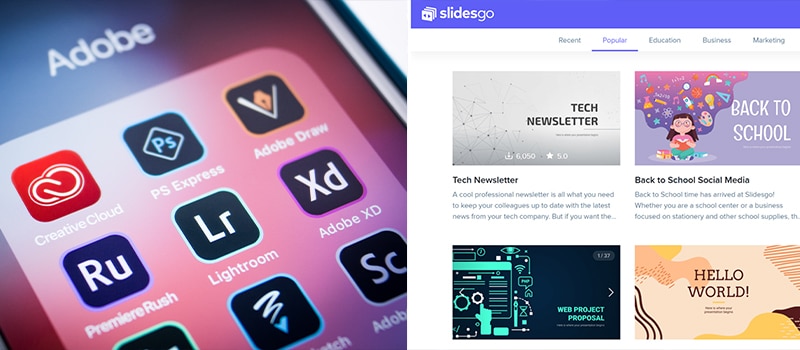
We all love a free resource! Thankfully, there’s plenty available to help you in your creation of a brand deck.
With these online tools, you can make a great start without committing to added expenses for popular SaaS tools, such as Photoshop. To help you get started on your branding journey, try these out:
Pro Brand Builder: Your brand deck shouldn’t be thrown together willy nilly and if you’ve taken the time and attention to engage a solid agency or freelancer to develop your brand, then providing you with a branding deck to guide you will be their bread and butter.
Adobe Creative Suite: If you have a professional in-house, they should have the chops to create your branding deck to guide the rest of the team.
Canva is extremely popular among professional and beginner designers alike. The platform offers a wide range of customizable templates for presentations, social media, infographics, and more.
Google Slides is super easy to use and provides various presentation templates that you can easily edit and share with your team.
PowerPoint remains popular. Microsoft's popular presentation software offers a variety of free templates suitable for brand decks. You can use a Powerpoint template to create an engaging branding deck.
Over To You
Creating a well-designed, impactful branding deck is essential for any company looking to establish a strong, consistent brand identity.
By understanding the key elements of a branding deck and following the steps outlined in this guide, you'll be well on your way to crafting a captivating brand story and a cohesive brand image that can give your whole brand direction.
Remember, a great brand deck needs to tick boxes to look good, but there has to be substance. It should be more than just a professional, slick presentation.
It should clearly communicate your brand's essence and values, playing its part in your brand story in a way that forges an emotional connection with the audience.
Even if you already have a brand deck, you should review it regularly and update it as your own brand evolves.
FAQs
1. How long should a branding deck be?
There's no set length for a branding deck, but it should be concise and visually engaging. Condensing big ideas into bite-sized chinks is always advisable. Aim for 10-20 slides, focusing on key elements like brand story, values, and positioning.
2. How often should I update my branding deck?
Update your branding deck whenever significant changes occur in your brand identity or offerings. Regular reviews can also help ensure your branding remains fresh and relevant.
3. How can I make my branding deck visually appealing?
Use a consistent color palette, typeface, typography, and design elements that align with your brand identity to create a visually appealing brand deck.
4. How much does it cost to create a branding deck?
The cost of creating a branding deck varies depending on the software you use and whether you hire a professional designer. However, using free templates and resources where possible can help minimize expenses.
5. Can I use my branding deck in my marketing materials?
Absolutely! Your branding deck serves as a kind of blueprint and a reference for your marketing materials, ensuring consistency in design and messaging across all platforms.
On-Demand Digital Program
Brand Master Secrets
Make the transition from hired-gun to highly valued brand strategist in less than 30 days. The systems, frameworks and tools inside this comprehensive program are all you need to level up.








